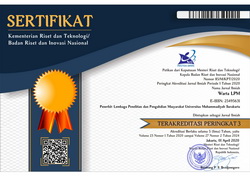Peningkatan Pengetahuan Petani melalui Pelatihan Pembuatan Pupuk Organik Cair di Desa Karangrejo, Gumukmas, Kabupaten Jember.
DOI:
https://doi.org/10.23917/warta.v26i1.1266Keywords:
Organic fertilizer, LOF, counceling, Healthy soilAbstract
The use of agrochemicals is still an option in terms of providing fast nutrition and increasing plant growth more efficiently to a certain extent. However, its continuous use results in a decrease in soil quality and soil fertility, which in turn causes the accumulation of heavy metal ions in plant tissues, and affects nutritional yields and food safety. The community service activities were carried out by the SBF (Soil Biodiversity and Fertility) team of the Jember University Soil Science study program in Karangrejo Village, Gumukmas District, Jember Regency. Field visits were conducted on farmers' fields to review, evaluate and discuss qualitative characteristics of soil properties. This service activity aims to increase understanding of sustainable soil fertility management and training in making liquid organic fertilizer based on a local bacterial consortium. The results of the activity showed that farmers' knowledge of the parameters of soil properties, especially pH, nutrients, and soil organic matter, was still minimal. The level of acidity (pH) of the soil determines the factors of production through the ease with which nutrients are absorbed by plants as well as the possibility of the presence of toxic elements that can interfere with plant growth. Knowledge of soil pH is needed in relation to nutrient management and liming. A deeper understanding of several parameters of soil properties, especially soil pH values, needs to be emphasized and followed up through mentoring activities. Mentoring activities as follow-up activities for farmer groups are carried out with the target output of liquid organic fertilizer products. Entrepreneurship training for farmer groups members also needs to be carried out to build an entrepreneurial spirit and added value from livestock products by farmers so that the farmer's household economy can sustainable.
Downloads
References
Ahmad, A. G. M., Attia, A. Z. G., Mohamed, M. S., & Elsayed, H. E. (2019). Fermentation, formulation and evaluation of PGPR Bacillus subtilis isolate as a bioagent for reducing occurrence of peanut soil-borne diseases. Journal of Integrative Agriculture, 18(9), 2080–2092. https://doi.org/10.1016/S2095-3119(19)62578-5
Ainy, I.T.E. 2008. Kombinasi antara Pupuk Hayati dan Sumber Nutrisi dalam Memacu Serapan Hara, Pertumbuhan, serta Produktivitas Jagung (Zea mays L.) dan Padi (Oryza sativa L.). [tesis]. Sekolah Pasca Sarjana, Institut Pertanian Bogor. BogorSelada (Lactucca sativa L.) pada Sistem Hidroponik. Tesis. Sekolah Pasca Sarjana, Institut Pertanian Bogor. Bogor.
Asyiah, I.N., Prihatin, J, Hastuti, A.D., Winarso, S., Widjayanthi, L., Nugroho, D., Firmansyah, K., and Pradana, A.P. 2021. Cost-effective bacteria-based bionematicide formula to control the root-knot nematode Meloidogyne spp. on tomato plants. Biodiversitas. 22 (6): 3256-3264.
Fadiluddin, M. 2009. Efektivitas Formula Pupuk Hayati dalam Memacu Serapan Hara, Produksi dan Kualitas Hasil Jagung dan Padi Gogo di Lapang. [tesis]. Mayor Biologi Tumbuhan, Sekolah Pasca Sarjana, Institut Pertanian Bogor. Bogor.
Farnia, A., Hasanpoor, K., 2015. Comparison between effect of chemical and biological fertilizers on yield and yield components in wheat (Triticum aestivum L.). Indian J. Nat. Sci. 5 (30), 7792–7800.
Fasusi, O.A., Cruz, C., Babalola, O.O., 2021. Agricultural sustainability: microbial biofertilizers in rhizosphere management. Agriculture 11, 163. https://doi.org/10.3390/agriculture11020163.
Goulding, K.W., 2015. International Fertiliser Society, Cambridge, U.KFactors Affecting Soil pH and the Use of Different Liming Materials, Agronomic Conference - The International Fertiliser Society2015. Factors Affecting Soil pH and the Use of Different Liming Materials, Agronomic Conference - The International Fertiliser Society.
Itelima, J.U., Bang, W.J., Onyimba, I.A., Oj, E., 2018. A review: biofertilizer; a key player in enhancing soil fertility and crop productivity. J. Microbiol. Biotechnol. Rep. 2 (1), 22–28.
Pereira, S. I. A., Abreu, D., Moreira, H., Vega, A., & Castro, P. M. L. (2020). Plant growth-promoting rhizobacteria (PGPR) improve the growth and nutrient use efficiency in maize (Zea mays L.) under water deficit conditions. Heliyon, 6(10). https://doi.org/10.1016/j.heliyon.2020.e05106
Sneha, S., Anitha, B., Sahair, R.A., Raghu, N., Gopenath, T.S., Chandrashekrappa, G.K., Basalingappa, K.M., 2018. Biofertilizer for crop production and soil fertility. Acad. J. Agric. Res. 6 (8), 299–306.
Sun, B., Gu, L., Bao, L., Zhang, S., Wei, Y., Bai, Z., Zhuang, G., Zhuang, X., 2020. Application of biofertilizer containing Bacillus subtilis reduced the nitrogen loss in agricultural soil. Soil Biol. Biochem. 148, 107911.
Syed, S., Tollamadugu, N. V. K. V. P., & Lian, B. (2020). Aspergillus and Fusarium control in the early stages of Arachis hypogaea (groundnut crop) by plant growth-promoting rhizobacteria (PGPR) consortium. Microbiological Research, 240, 126562. https://doi.org/10.1016/J.MICRES.2020.126562
Wei, M., Liu, X., He, Y., Xu, X., Wu, Z., Yu, K., & Zheng, X. (2020). Biochar inoculated with Pseudomonas putida improves grape (Vitis vinifera L.) fruit quality and alters bacterial diversity. Rhizosphere, 16, 100261. https://doi.org/10.1016/J.RHISPH.2020.100261
Wibowo et al., 2009. Kandungan Hormon IAA, Serapan Hara, dan Pertumbuhan Beberapa Tanaman Budidaya sebagai Respon Aplikasi Pupuk Hayati. Jurnal Ilmu Pertanian Indonesia. 14 (3): 177-183.
Winarso, S., Anggriawan, R., Subiksa, IGM., Ganestri, R.G., Intansari, S.R. and Budianta, D. 2022. Macronutrients (NPK) balance in rice field and dryland maize cropping systems. Journal of Degraded and Mining Lands Management 10(1):3945-3951, doi:10.15243/jdmlm. 2022.101.3945.
Winarso, S., Subchan, W., Haryanti, A., Setiawati, T.C., and Romadhona, S. 2021. Increasing the abundance of microorganisms in a regosol soil using biopelet fertilizer composed from biochar, chicken manure, and shrimp waste to increase soil fertility. Journal of Degraded and Mining Lands Management. 8(4): 2881-2890.
Downloads
Submitted
Accepted
Published
How to Cite
Issue
Section
License
Copyright (c) 2023 Warta LPM

This work is licensed under a Creative Commons Attribution 4.0 International License.















